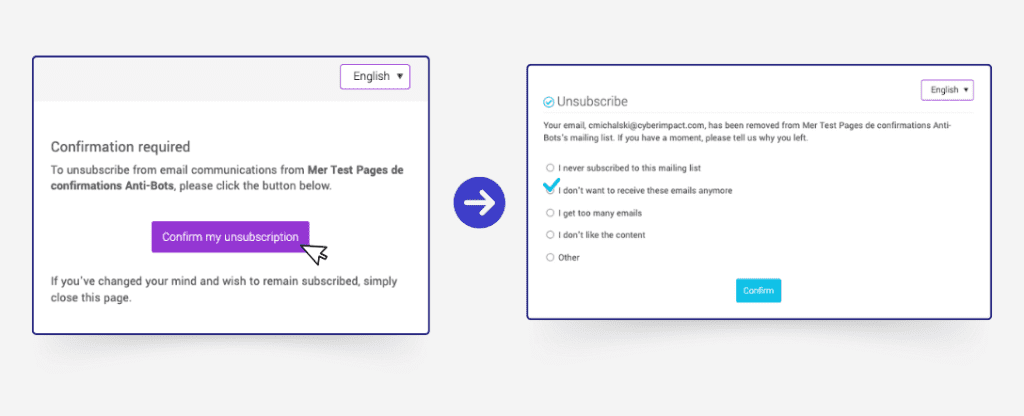If you have seen high click rates in your email campaigns, you may have noticed spikes in activity after sending. This often means you have encountered robot clicks. These automated actions can skew your metrics, making assessing your campaign’s performance challenging. In this post, we’ll break down what robot clicks are, why they happen, and how you can minimize their impact.
Table of Contents
What Are Bot Clicks?
Robot clicks, also known as automated clicks or server clicks, occur when bots or automated systems interact with the links in your emails. Your recipients do not make these clicks. Security tools like spam filters or email security gateways create them. These tools often test links for malicious content before the email reaches the recipient’s inbox.
Unlike genuine clicks, robot clicks don’t indicate interest or engagement. They are a result of the greater focus on email security. This includes anti-phishing measures used by email providers and companies.
Why Bot Clicks Happen?
The primary reason for robot clicks is to protect recipients from harmful links and phishing attacks. Here’s a closer look at some scenarios where robot clicks occur:
- Spam filters testing links: Many email security systems automatically click every link in an email to verify its safety. This happens before the email even appears in the recipient’s inbox.
- Corporate security policies: Large companies often use advanced email security tools. These tools scan links as part of their regular procedures. These tools prioritize security over email engagement accuracy.
- Email testing and tracking: Some platforms track link behaviour for deliverability testing, which can inadvertently trigger robot clicks.
Automated interactions are helpful. However, they can affect email metrics, like click-through rates (CTR). This may lead to reporting errors.
Understanding Email Opens and Robot Activity
Robot activity doesn’t stop at clicks; it can also impact email open rates. Here’s how:
- Image previews: Many email clients and spam filters load images, including tracking pixels, as part of their scanning process. This can register as an “open” even if the recipient hasn’t interacted with the email.
- Automated processes: Security systems can mimic openings to check the email’s content for phishing or other harmful activities.
- Mobile and desktop clients: Some email apps preload email content, including images, to improve user experience. While convenient, this behavior can inflate open rates.
While these “opens” are not genuine, they’re often unavoidable in modern email marketing.
Identifying Bot Clicks and Opens in Your Metrics
Spotting robot clicks and opens in your campaign reports is essential for maintaining accurate insights. Here are some common indicators:
- Immediate spikes: Several clicks or opens happening within minutes of sending an email usually means automated activity.
- Unusual patterns: Repeated opens or clicks from the same IP address or domain suggest automation.
- High open rates with low engagement: If many people open your emails but don’t interact with the content, bots might be the cause.
How Robot Activity Affects Your Campaigns
Robot clicks and opens can have significant implications for your email campaigns:
- Distorted metrics: Inflated open and click-through rates make it difficult to gauge recipient engagement accurately.
- Skewed A/B testing results: Automated activity can compromise the reliability of split-testing campaigns.
- False positives in lead scoring: High open and click activity from bots can result in incorrect lead prioritization.
- Misleading ROI calculations: Inflated metrics can lead to flawed conclusions about your campaign’s effectiveness.
How Bots Interact with Unsubscribe Links
One of the unintended consequences of bot activity is their interaction with unsubscribe links in emails. Email security systems use bots that click on all links in an email.
They do this to check for harmful content. This includes the unsubscribe link. This can cause accidental unsubscribes. Recipients may be taken off your mailing list without knowing or wanting it.
To address this, some email platforms, including Cyberimpact, have implemented measures such as requiring a confirmation step for unsubscribes. This process ensures that only genuine unsubscribe requests get processed, helping you maintain the integrity of your subscriber list.
How to Handle Robot Activity
Fortunately, there are steps you can take to mitigate the impact of robot clicks and opens:
- Use bot filtering tools: Many email marketing platforms now offer built-in features to detect and filter out bot activity. These tools analyze patterns like instant clicks, repeated link interactions, and image preloading to exclude them from your reports.
- Monitor engagement timing: Pay close attention to the timing of clicks and opens. If a high percentage of activity occurs immediately after sending, consider these as bot interactions. Segmenting these metrics can clarify your campaign’s true performance.
- Analyze click timing: Identify abnormal activity spikes, such as a sudden surge in clicks just seconds after sending, to better filter out automated interactions.
- Assess engagement beyond clicks: Look at other indicators like time spent on the page or actual conversions to avoid drawing misleading conclusions.
What Cyberimpact Does to Prevent Bot-Related Issues
To limit unsubscribes caused by bots, Cyberimpact includes a confirmation page when users click to unsubscribe. This extra step makes sure that only real unsubscribes are handled. It stops bots from accidentally taking users off your mailing list. A small change significantly reduces erroneous unsubscribes. But that’s not all. Other sensitive actions in emails now require additional validation to minimize errors and ensure data accuracy.

These improvements apply to both subscriber emails and our communications with clients. The following actions are now protected:
- Unsubscribes
- Consent confirmations
- Responses to micro-surveys
- Subscription confirmation after form sign-up
- Sender address validation
- Account email validation
Additionally, Cyberimpact plans to introduce more tools this year to address issues caused by bot activity. These features aim to ensure your email metrics remain accurate and reflective of genuine engagement.
Best Practices to Minimize Robot Clicks
Here are some strategies to mitigate the impact of robot clicks and opens:
- Avoid overloading emails with links: Keep your email design simple. Include only important links to reduce the chance of multiple bot clicks.
- Track engagement beyond clicks: Use other metrics like conversions, time spent on your landing page, or direct replies. These can help improve your analysis.
- Test and optimize: Regularly test your campaigns and analyze click data to identify patterns indicative of robot activity.
- Communicate with your email service provider: Discuss bot-related issues with your email platform’s support team. They may have tools or solutions to address the problem.
Not sure how to test your email marketing campaigns or newsletters? Check out this free course in the Cyberimpact Academy to learn how and discover other tools that could be helpful during testing.
Conclusion
Robot clicks and opens are common in email marketing today. However, they don’t have to ruin your campaigns.
You can take control of your metrics. First, understand what causes them.
Next, look for patterns. Finally, use strategies to reduce their effects. Accurate reporting helps you measure success. It also ensures you make informed decisions for your future campaigns.
Remember, your goal is to connect with your audience, not bots. By staying proactive, you can focus on building meaningful engagement and delivering real value to your recipients.
